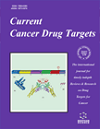- Home
- A-Z Publications
- Current Cancer Drug Targets
- Previous Issues
- Volume 2, Issue 1, 2002
Current Cancer Drug Targets - Volume 2, Issue 1, 2002
Volume 2, Issue 1, 2002
-
-
Prospects for Anti-Neoplastic Therapies Based on Telomere Biology
More LessAuthors: s.A. Stewart and W.C. HahnThe maintenance of specialized nucleoprotein structures at the ends of human chromosomes called telomeres is essential for chromosome stability, and plays a fundamental role in the regulation of cellular lifespan. Without new synthesis of telome-res, chromosome ends shorten with progressive cell division, eventually triggering either replicative senescence or apoptosis when telomere length becomes critically short. Read More
-
-
-
Diphtheria Fusion Protein Therapy of Chemoresistant Malignancies
More LessAuthors: A.E. Frankel, P. Rossi, T.M. Kuzel and F. FossPatients with widespread cancer respond initially to combination chemotherapy, immunotherapy, and / or radiotherapy, but most relapse with chemoresistant disease. Novel methods of killing resistant neoplastic stem cells are needed. One such approach is therapy with targeted toxins composed of tumor cell selective ligands covalently linked to group I peptide toxins (group II and III peptide toxins act on the cell surface Read More
-
-
-
Integrins as Novel Drug Targets for Overcoming Innate Drug Resistance
More LessBy J.S. DamianoAcquired drug resistance continues to be one of the major obstacles hindering the successful treatment of many forms of cancer. Compounds utilized as antagonists of these cytoprotective mechanisms have, for the most part, proven to be ineffective at overcoming clinical resistance to cytotoxic drugs. Recently, the tumor cell microenvironment has been found to have a significant bearing on the survival of tumor cells f Read More
-
-
-
WT1 as a Novel Target Antigen for Cancer Immunotherapy
More LessAuthors: Y. Oka, A. Tsuboi, O.A. Elisseeva, K. Udaka and H. SugiyamaWild-type Wilms' tumor gene WT1 is expressed at high levels not only in most of acute myelocytic, acute lymphocytic, and chronic myelocytic leukemia, but also in various types of solid tumors including lung cancer. We tested the ability of the gene product (WT1) to serve as a target antigen for tumor -specific immunotherapy both in human in vitro system and mouse in vivo system. In the latter, we can evaluate the e Read More
-
-
-
Sulfonamides and Sulfonylated Derivatives as Anticancer Agents
More LessAuthors: A. casini, A. Scozzafava, A. Mastrolorenzo and C.T. SupuranThe sulfonamides constitute an important class of drugs, with several types of pharmacological agents possessing antibacterial, anti-carbonic anhydrase, diuretic, hypoglycemic and antithyroid activity among others. A host of structurally novel sulfonamide derivatives have recently been reported to show substantial antitumor activity in vitro and / or in vivo. Although they have a common chemical motif of aromatic / heter Read More
-
-
-
Receptor Selective Synthetic Retinoids as Potential Cancer Chemotherapy Agents
More LessBy D.L. CroweFor many years, the vitamin A metabolite retinoic acid (RA) has been known to have profound effects on development, cellular proliferation and differentiation, and tumor growth and invasion. The wide-ranging effects of RA on cellular proliferation and migration have made it a useful chemotherapeutic agent in the treatment of many types of cancer. In the last fifteen years, with the discovery of nuclear receptors for Read More
-
Volumes & issues
-
Volume 25 (2025)
-
Volume 24 (2024)
-
Volume 23 (2023)
-
Volume 22 (2022)
-
Volume 21 (2021)
-
Volume 20 (2020)
-
Volume 19 (2019)
-
Volume 18 (2018)
-
Volume 17 (2017)
-
Volume 16 (2016)
-
Volume 15 (2015)
-
Volume 14 (2014)
-
Volume 13 (2013)
-
Volume 12 (2012)
-
Volume 11 (2011)
-
Volume 10 (2010)
-
Volume 9 (2009)
-
Volume 8 (2008)
-
Volume 7 (2007)
-
Volume 6 (2006)
-
Volume 5 (2005)
-
Volume 4 (2004)
-
Volume 3 (2003)
-
Volume 2 (2002)
-
Volume 1 (2001)
Most Read This Month
Article
content/journals/ccdt
Journal
10
5
false
en


